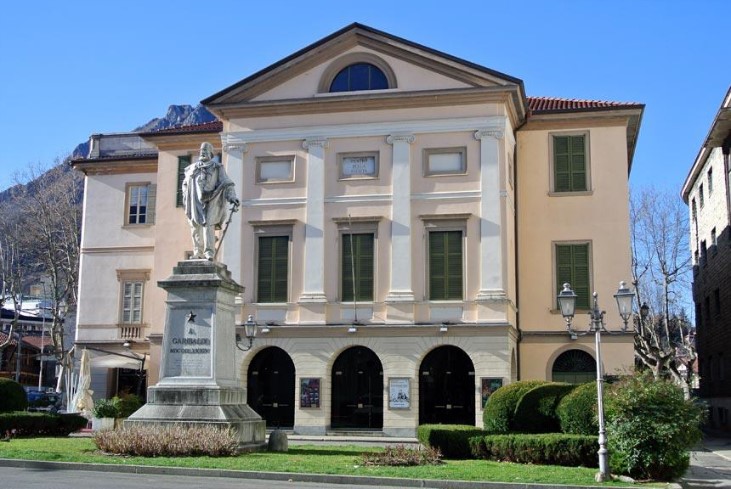AUTORE: Giuseppe La Greca
TUTOR: Ing. Giovanni Franchi
MASTER: “Project and contract management in construction works” a.a 2019/20
Lo scopo della presente tesi di Master è quello di sviluppare un modello di Project management da utilizzare per la gestione dei lavori di restauro e recupero funzionale del Teatro della Società di Lecco.
L’edificio fu progettato dall’architetto Giuseppe Bovara, secondo lo stile neoclassico, e fu inaugurato nell’ottobre 1844 con l’opera “Anna Bolena” di Gaetano Donizetti.
Venne costruito su richiesta di un ristretto numero di famiglie appartenenti alla nobiltà e all’alta borghesia cittadina, ma da subito venne aperto a tutta la cittadinanza.
Attualmente il Teatro è il risultato di una serie di interventi di ampliamento, ristrutturazione e restauro eseguiti a più riprese nel secolo scorso.
Nel 2016 è stata eseguita un’attività di studio del compendio che ha riguardato, in particolare, il rilievo geometrico, materico e del degrado degli elementi strutturali e la conseguente verifica di vulnerabilità sismica; sulla base delle risultanze degli studi eseguiti, il Teatro viene chiuso perché non ritenuto agibile.
Necessita pertanto gestire il progetto del recupero funzionale del Teatro per poterlo ridare alla Città nel più breve tempo possibile: da qui la necessità di individuare un approccio nuovo, che veda il progetto guidato dal Project manager, dotato di “Technical skills” e “Leadership skills”.
Nel costruire il modello gestionale si prende a riferimento lo standard di project management del PMBOK® 6th Edition, eseguendo opportune azioni di tailoring e adattamento alla normativa italiana cogente, in particolare il D.Lgs. 50/2016 “Codice dei contratti pubblici”.
Il progetto, definito dal PMI come “…a temporary endeavor undertaken to create a unique product, service, or result.” viene sviluppato secondo le seguenti fasi sequenziali:
Programmazione —-> Progettazione —-> Esecuzione —-> Collaudo
all’interno delle quali vengono applicati iterativamente i processi di project management.
Vengono identificati e analizzati gli stakeholders, processo chiave, non sempre compreso, per la riuscita del progetto.
Risultato finale è il Project management plan, quale strumento dinamico da usare nella gestione del progetto di realizzazione dell’opera pubblica.
Ci si è posti altresì la domanda: possiamo ulteriormente migliorare? E se applicassimo il modello di miglioramento continuo Lean Six Sigma?
Questo modello è basato sul concetto di “produrre valore” eliminando gli “sprechi” e sull’utilizzo di strumenti statistici per analizzare i problemi emersi da una raccolta dati di precedenti progetti.
Il problema appare essere quello del rispetto dei tempi di esecuzione e il diagramma di Ishikawa ci aiuta nell’evidenziare e organizzare le possibili cause (cause potenziali) che influenzano la Critical to Quality in esame.
Attraverso l’analisi dei dati e dei processi sono state individuate e pesate le cause ritenute prioritarie (cause radice) e tramite il Creative thinking e i modelli Lean sono state individuate le soluzioni.
THE TEATRO DELLA SOCIETA’ OF LECCO: THE PROJECT MANAGEMENT OF A PUBLIC WORK
The purpose of this Master’s thesis is to develop a project management model to be used for the management of the restoration and functional recovery works of the Teatro della Società of Lecco.
The building was designed by the architect Giuseppe Bovara, in the neoclassical style, and was inaugurated in October 1844 with the opera “Anna Bolena” by Gaetano Donizetti.
It was built at the request of a small number of families belonging to the nobility and the upper middle class of the city, but it was immediately opened to all citizens.
Currently the theatre is the result of a series of expansion, restructuring and restoration interventions carried out several times in the last century.
In 2016, a study of the compendium was carried out which concerned, in particular, the geometric, material and degradation survey of the structural elements and the seismic vulnerability assessment; on the basis of the results, the theatre is closed because it is not considered safe.
It is therefore necessary to manage the project for the functional recovery of the theatre in order to give it back to the City in the shortest possible time: hence the need to identify a new approach, which sees the project led by the Project manager, with technical and leadership skills.
In constructing the management model, the PMBOK® 6th Edition project management standard is taken as a reference, carrying out appropriate tailoring and adaptation actions to the mandatory Italian legislation, in particular, Legislative Decree 50/2016 “Code of public contracts”.
The project, defined by PMI as “…a temporary endeavor undertaken to create a unique product, service, or result.” is developed according to the following sequential phases:
Programming —-> Design —-> Execution —-> Testing
within which the project management processes are applied iteratively.
Stakeholders are identified and analyzed, a key process, not always understood, for the success of the project.
Final result is the Project management plan, as a dynamic tool to be used in the management of the public works projects.
The question also arose: can we improve further? What if we applied the Lean Six Sigma continuous improvement model?
This model is based on the concept of “producing value” by eliminating “waste” and on statistical tools to analyze the problems that emerged from a data collection of previous projects.
The problem appears to be compliance with execution times and the Ishikawa diagram helps us in highlighting and organizing the possible causes (potential causes) that influence the Critical to Quality in question.
Through the analysis of data and processes, the priority causes (root causes) were identified and weighed, and the solutions were identified through Creative thinking and Lean models.


